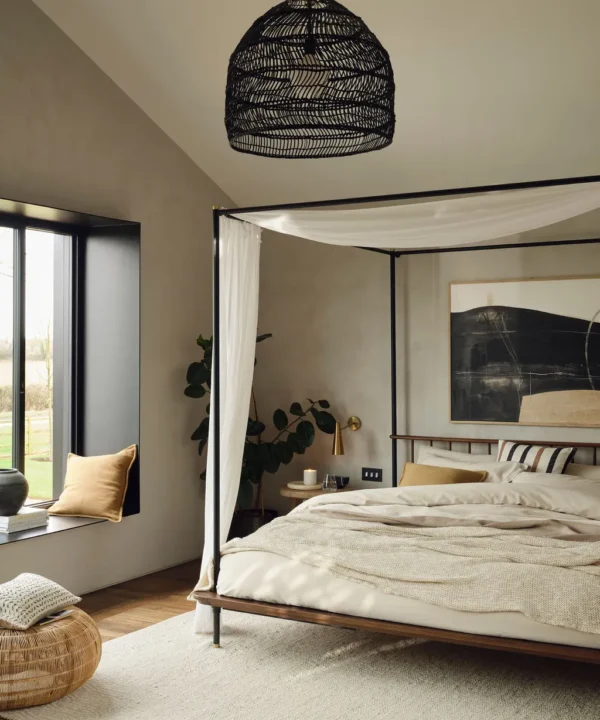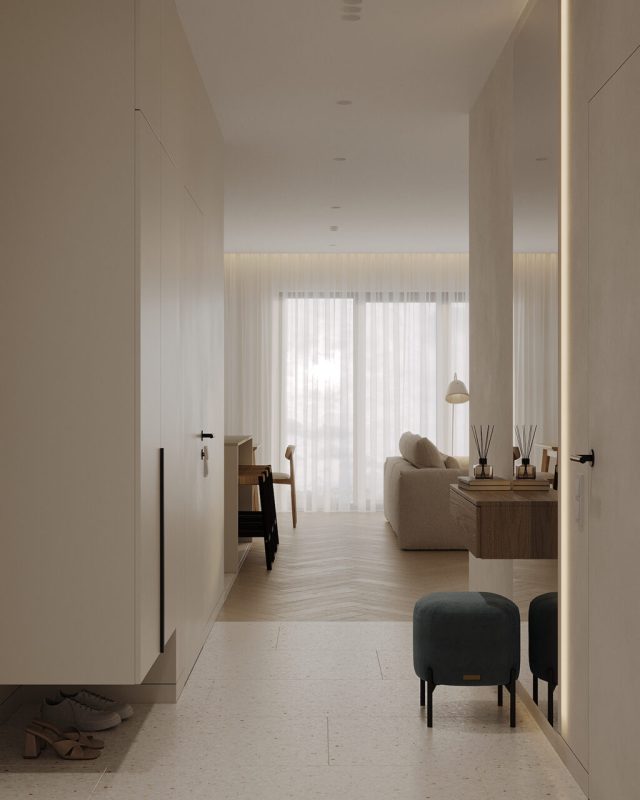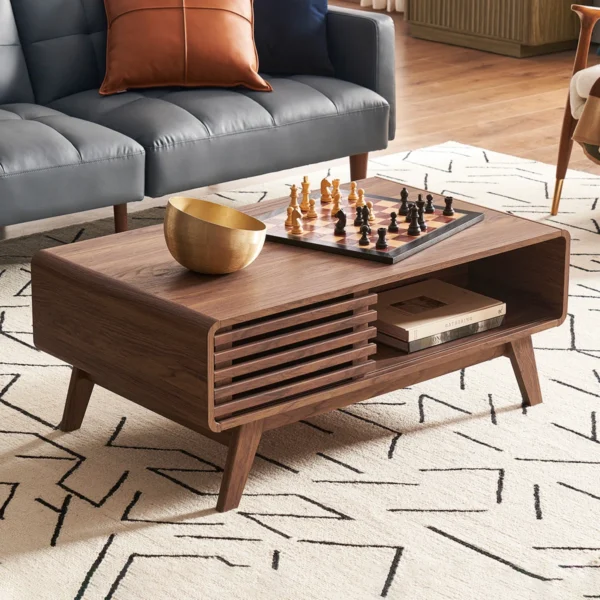Digital Detox Interiors: Designing Homes That Help You Log Off

In a world buzzing with notifications, pings, and endless scrolling, our homes should be a refuge , not just a place to recharge our devices, but to recharge ourselves. Designing a space that encourages rest, mindfulness, and presence is no longer just a luxury; it’s a form of self-care. “Digital detox” isn’t about rejecting technology altogether; it’s about reclaiming the balance between human and digital life. Interior design plays a profound role in this , not just in what we see, but in how we feel. A truly mindful home can slow our pace, soothe our senses, and gently invite us back into the present moment. Here are 17 ideas to help you design a home that encourages calm, creativity, and conscious living , a space that helps you log off, tune in, and breathe again.
1. Designate Tech-Free Rooms

Every home needs a sanctuary , a space where screens are politely left outside. The bedroom is the most transformative place to start. Keep it free of TVs, tablets, and chargers, and instead fill it with softness: woven linens, books, diffused lighting, and natural scents. Let it become a room that signals rest and reflection. If you have extra space, extend this idea to a reading nook or meditation corner. Tech-free rooms remind your mind what stillness feels like , and teach it to crave that feeling again.
2. Add Minimalistic Décor

Minimalism isn’t about owning less , it’s about choosing better. A minimalistic room reduces mental noise by replacing clutter with clarity. Think clean lines, neutral tones, and furniture that breathes rather than fills. Choose a few meaningful objects that bring warmth, rather than dozens competing for attention. When every surface is intentional, your eyes , and your mind , rest. In this kind of design, space becomes not empty, but open; a visual pause that helps you focus on what truly matters.
3. Fill Rooms with Healthier Distractions

Designing to log off doesn’t mean stripping joy away; it means replacing digital noise with tactile delight. Create little analog temptations , a basket of art supplies, a vinyl player, an open book on the table, a corner for puzzles or music. These “healthier distractions” bring your attention back to the physical world. They reward curiosity, touch, and creativity. When your surroundings invite presence, you stop seeking stimulation from your phone , because the real world feels rich again.
4. Designate a Screen-Free Zone

If an entire room isn’t possible, define a clear screen-free zone. It could be a breakfast table, a garden bench, or a cozy chair by the window. Add elements that encourage mindfulness: a soft throw, a stack of books, or a small plant. Over time, these spaces develop emotional gravity , your mind associates them with calm. A physical boundary becomes a mental one, and you begin to reclaim your attention, one corner at a time.
5. Let Natural Light Lead the Way

Light is life’s first rhythm. Homes that invite daylight regulate your energy far better than screens ever could. Use gauzy curtains, reflective surfaces, and open layouts to let sunlight pour in during the day. As evening approaches, transition to softer lamps, candles, or amber bulbs. Avoid harsh overhead glare. Natural light design reminds your body when to awaken, when to slow down, and when to truly rest , it’s a gentle, architectural form of therapy.
6. Arrange Furniture for Connection

The layout of a room subtly teaches us how to live in it. If every sofa faces a TV, the screen becomes the center of life. Shift that power by arranging furniture toward conversation, windows, or even an art piece. Choose round or modular seating that draws people together. Add side tables for tea or books instead of remotes. When your living space favors eye contact over screen time, it naturally redefines connection , from digital to human.
7. Embrace Nature in Design

The presence of nature calms the nervous system in ways no app can replicate. Bring organic textures into your home , wood, stone, clay, and woven fibers. Add greenery: hanging plants in corners, potted herbs in the kitchen, or a leafy palm by the window. These elements don’t just decorate; they heal. They oxygenate air, balance humidity, and invite rhythm. A biophilic home is an antidote to overstimulation , reminding you to breathe with the world again.
8. Choose a Calming, Grounded Color Palette

Color changes mood faster than you realize. Cool neutrals and earthy tones , beige, sage, clay, cream, and soft gray , slow the pulse and soothe overstimulated senses. Avoid sharp contrasts and artificial brights that mimic digital screens. Instead, choose hues that absorb light softly, creating emotional warmth. The right palette quiets the eye and the mind alike. When walls feel like a deep exhale, you’ve achieved the essence of digital detox design.
9. Create a Morning Ritual Corner

Our first moments shape our day. Dedicate a small area for rituals that don’t involve screens , a tea tray, a journal, or a meditation cushion by the window. Keep it uncluttered, sunlit, and comfortable. Ritual corners remind you to begin with awareness rather than urgency. Over time, they become a physical anchor for calm mornings , a cue that peace can be chosen, not found. Good design doesn’t force routine; it gently supports it.
10. Conceal Technology Gracefully

A true detox home doesn’t banish technology , it integrates it invisibly. Use cabinetry to hide routers, consoles, and cables. Choose furniture with built-in chargers or drawers for devices. Mount TVs that retract or blend with art. The less technology dominates your sightline, the less it dominates your thoughts. When screens fade into the background, design , and life , reclaims its beauty.
11. Bring Mindfulness Into the Kitchen

Cooking can be one of the most grounding digital detox rituals. Design your kitchen to support sensory connection: open shelving for visible ingredients, natural stone counters, and warm task lighting. Keep tech out , no phones, no TVs. Let texture, scent, and sound take over , the chop of vegetables, the simmer of soup. When we cook with presence, we feed more than the body.
12. Design for Acoustic Calm

Constant digital buzz leaves us sensitive to noise. Use rugs, curtains, and soft textiles to absorb echoes. Incorporate natural sound , wind chimes, fountains, or simply open windows for birdsong. Even silence can be designed: thick rugs, fabric wall panels, or bookshelves filled with texture dampen harsh acoustics. When sound softens, tension drops. Acoustic comfort turns the home into a true sanctuary of calm, where the loudest thing you hear is your own breathing.
13. Multipurpose Living Spaces for Mindful Living

The living room is often the heartbeat of the home , and, too often, the hub of screens. Redesigning it as a multipurpose sanctuary restores balance. Let it serve more than one mood: a cozy reading corner during the day, a space for gentle stretching, or a conversation zone at night. Incorporate flexible furniture , poufs, low tables, and soft rugs , that encourage fluid use rather than fixed attention on a TV. Store devices neatly out of sight to keep the room’s energy light and inviting.
14. Balcony Bliss: Designing an Urban Escape

Even the smallest balcony can become an oasis of calm when designed with intention. Replace clutter with comfort , a single chair with soft cushions, string lights that mimic dusk, and potted greenery that rustles gently in the breeze. Skip screens and let nature take center stage. The sound of the city fades when you introduce texture, scent, and movement , bamboo, lavender, or hanging planters that sway in rhythm with the air. Morning tea or twilight reflection here becomes its own form of meditation.
15. Reclaim the Dining Table for Connection

Family dinners have turned into silent scroll sessions. Reimagine your dining area as a device-free gathering spot. Set a no-phone rule during meals and make the table inviting , candles, real plates, linen napkins, maybe even a centerpiece of fresh herbs or flowers. When people sit down without screens, they look up. They talk, listen, and reconnect. The act of sharing food becomes slower, more intentional, more human.
16. Add Personal Touches That Tell Your Story

A truly restorative home feels like you. Incorporate personal details that speak to your memories and values , framed photos, a handwritten quote, handmade pottery, or souvenirs from meaningful places. These touches ground your space in authenticity and emotion, reminding you that home is more than aesthetics , it’s identity made visible. Avoid mass-produced décor and choose pieces with stories.
17. Comfortable Seating as the Heart of Stillness

Comfort isn’t indulgence; it’s an invitation to pause. In a digital detox home, seating design defines how you slow down. Choose sofas and chairs that embrace the body rather than posture it for multitasking , deep cushions, rounded arms, and tactile fabrics like linen or boucle. Add layered textures with throws and pillows that feel soft to the touch. Arrange them in clusters that encourage conversation or solitary unwinding. The goal is not perfection, but ease , a physical softness that helps your mind follow suit.
Finishing Notes
Designing a digital detox home isn’t about eliminating technology, but restoring harmony between life and living space. When light, layout, and texture align with intention, the home becomes a place that gently encourages calm and connection. These design choices remind us to slow down, breathe, and be fully present in our surroundings.
At Home Designing, we believe that thoughtful design is a form of wellness , where beauty meets balance and modern spaces nurture mindful living. Because sometimes, the most powerful upgrade isn’t in our devices, but in the quiet, intentional spaces that help us truly log off.







